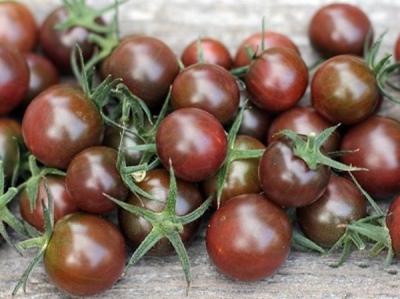
- Authors: Postnikova O.V.
- Year of approval: 2019
- Category: grade
- Growth type: indeterminate
- Appointment: fresh consumption, for whole fruit preservation
- Ripening period: mid-early
- Ripening time, days: 90-95
- Growing conditions: for open ground, for film greenhouses
- Bush height, cm: 180-220
- Leaves: medium, green
Afro cherry tomato is a hybrid, but despite this, it has good taste. Its popularity among summer residents is explained not only by the taste of the fruit, but also by the versatility of use, useful properties, and early ripening. And also the fact that this variety is well stored despite its tendency to cracking.
Breeding history
It was first bred in 2017, then it was registered, but allowed for cultivation in 2019. Conditionally, we can say that his parent, the one who received it, is O. V. Postnikova.
Description of the variety
The Afro cherry tomato bush is tall and reaches 180-200 cm. It is indeterminate, does not stop growing. A very developed plant, with leaves reaching medium length, green in color. Fruits are formed in 8-12 pieces per 1 bunch. The inflorescences are intermediate, the first are formed above 7-8 leaves, and the subsequent ones after 3 leaves.
The main qualities of the fruit
Fruits, reaching their ripeness, acquire a dark cherry color. They are round, slightly ribbed and small in size. Weight reaches about 45-50 g. Afro cherry tomato is a cocktail variety. The flesh of the fruit is dense and juicy, covered with a thick skin, which, unfortunately, tends to crack.
Taste characteristics
Tomatoes have a very pronounced sweet taste with subtle fruity notes. It is used for fresh food, as well as for canning with whole fruits.
Ripening and fruiting
Refers to medium early varieties. It takes up to 2 months from planting seedlings to harvesting, the full ripening period is 90-95 days. Fruiting in this type of tomato is long, the harvest is ready for harvesting throughout July-August.
Yield
The tomato of this variety is highly fruitful. Its yield is 10.2 kg per m2.
The timing of planting seedlings and planting in the ground
Seeds are prepared for germination in advance, planting for seedlings should be done in March about 40-50 days before planting already grown seedlings in the soil.
Directly the seedlings themselves are planted in the ground in May, when the plant is already a little stronger and has fairly large leaves.

Growing tomato seedlings is an extremely important process, because it largely depends on whether the gardener can harvest at all. All aspects must be taken into account, from seedbed preparation to planting in the ground.
Landing scheme
For planting seedlings in the ground, certain requirements should be followed in order to achieve a good timely harvest. Some features:
the distance between plants must be at least 35 cm;
the distance between the rows of tomatoes is also at least 35 cm;
planting density no more than 3-5 plants per m2

Growing and caring
When growing an Afro cherry tomato, it is required to carry out a garter of plants so that they do not bend or fall, since they are quite tall. And it is also required to carry out the formation in order to prevent thickening.
If the weather conditions are warm enough in the growing area, then this tomato variety ripens well in the open field. And if the climate is cold, then you need to plant it in a greenhouse.




A plant needs different micronutrients at each stage of growth. All fertilizers can be divided into two groups: mineral and organic. Folk remedies are often used: iodine, yeast, bird droppings, eggshells.
It is important to observe the rate and period of feeding. This also applies to folk remedies and organic fertilizers.
Disease and pest resistance
It is highly resistant to disease.


Growing regions
It grows well and bears fruit in areas with different climatic conditions - both in the central regions of our country and in the west and east. This species is specially bred for cultivation in areas with different meteorological situations.
Afro cherry tomato contains a lot of useful vitamins and minerals. It is recommended to eat it preferably fresh for greater benefits. But even in canned food, it does not lose most of its beneficial properties.
It can be used for the prevention of certain diseases, namely: atherosclerosis, oncology and diseases of the cardiovascular system. All this is due to such substances in the composition as magnesium, potassium, sodium, phosphorus, calcium, zinc, iron and iodine. And also due to the presence of vitamins K, E, A and group B.

























































































